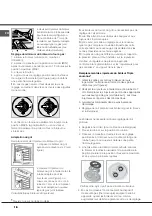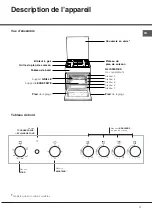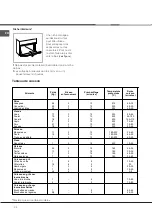
12
GB
Switching the appliance off
Disconnect your appliance from the electricity supply
before carrying out any work on it.
Cleaning the appliance
!
Never use steam cleaners or pressure cleaners on
the appliance.
• The stainless steel or enamel-coated external parts
and the rubber seals may be cleaned using a
sponge that has been soaked in lukewarm water
and neutral soap. Use specialised products for the
removal of stubborn stains. After cleaning, rinse well
and dry thoroughly. Do not use abrasive powders or
corrosive substances.
• The hob grids, burner caps, flame spreader rings
and burners may be removed to make cleaning
easier; wash them in hot water and non-abrasive
detergent, making sure all burnt-on residue is
removed before drying them thoroughly.
• Clean the terminal part of the flame failure safety
devices* frequently.
• The inside of the oven should ideally be cleaned
after each use, while it is still lukewarm. Use hot
water and detergent, then rinse well and dry with a
soft cloth. Do not use abrasive products.
•
Clean the glass part of the oven door using a
sponge and a non-abrasive cleaning product, then
dry thoroughly with a soft cloth. Do not use rough
abrasive material or sharp metal scrapers as these
could scratch the surface and cause the glass to
crack.
• The accessories can be washed like everyday
crockery, and are even dishwasher safe.
Inspecting the oven seals
Check the door seals around the oven regularly. If the
seals are damaged, please contact your nearest
Authorised After-sales Service Centre. We recommend
that the oven is not used until the seals have been
replaced.
Replacing the oven light bulb
1. After disconnecting the oven
from the electricity mains,
remove the glass lid covering
the lamp socket (
see figure).
2. Remove the light bulb and
replace it with a similar one:
voltage 230 V, wattage 25 W,
cap E 14.
3. Replace the lid and reconnect the oven to the
electricity supply.
Gas tap maintenance
Over time, the taps may become jammed or difficult to
turn. If this happens, the tap must be replaced.
!
This procedure must be performed by a qualified
technician authorised by the manufacturer.
The catalytic self-cleaning system*
Some models have oven liners coated with a porous
enamel also known as catalytic enamel.
When hot, this enamel destroys all greasy food
particles. For this "oxidation" to occur, the oven liners
must reach a temperature of at least 170°C.
When cooking is done, should some grease and food
particles remain on the oven liners, leave the appliance
on with nothing in it and the door shut, with the OVEN
knob on the maximum setting, for 60-90 minutes,
depending on the degree of soil. You can remove
large amounts of grease using hot water and a soft
brush.
!
Catalytic enamel is very strong, but nonetheless,
avoid:
scratching the enamel with sharp objects (i.e. a knife),
and using abrasive detergents or products to clean it,
otherwise you will destroy the enamel's self-cleaning
properties.
Assistance
!
Never use the services of an unauthorised technician.
Please have the following information to hand:
• The type of problem encountered.
• The appliance model (Mod.).
• The serial number (S/N).
The latter two pieces of information can be found on
the data plate located on the appliance.
Care and maintenance
*
Only available in certain models.
Содержание H6GG1E FR
Страница 28: ...FR 09 2013 195110515 01 XEROX FABRIANO ...













































